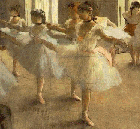Soundtracks:
Stalker
10




|
Boléro (Piece for orchestra
originally written for ballet)
Background
Born in the south of France, in a region bordering Spain, Ravel liked
hearing his mother, a woman of Spanish-Bask descent, speak Spanish and
tell about her childhood in Madrid. All his life, Ravel missed his birth
country, and wrote several pieces with Spanish inspiration.
Ravel took it upon himself to write ballet music, to his friend's request,
dancer Ida Rubinstein. The original idea was to orchestrate 6 pieces for
piano by Albeniz, but the rights were already promised to someone else.
Ravel focused on the intent to orchestrate piano works, of his own, but
eventually decided to compose an entirely new piece - The Bolero. In October
1928, he completed the work, and in November Rubinstein's group danced
to its sound in the Paris Opera House.

About Choreography
The dance presents a tavern, in which a single woman begins dancing.
Later, a group of men joins the dance. Tension rises and the woman starts
passing from one man to another, as the music grows in power and barely
restrained violence, although unchanging.
About the piece
The rhythm accompanying this work is that of a Spaniard dance called
"Fandango". Originally, it was supposed to be the piece's name,
but for unknown reasons Ravel and Rubinstein decided to change the name
to "Bolero". The general outline was repeating a theme, again
and again, changing neither melody nor rhythm. The work opens with a single
drum repeating a fixed rhythm. One flute begins playing the tune, and later
other instruments join it, creating a dance full of ecstasy and drama.
The crucial peak event in this piece is the change of key, occurring at
a certain point, from C major to E major, which leads to the finale - the
piece ends with a shocking chord played very loudly.
|